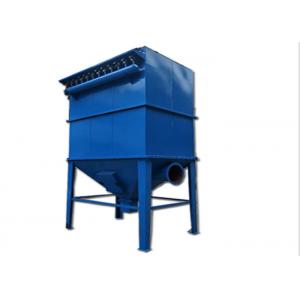Single Pulse Bag Baghouse Filter Cement Silo Top Dust Collector Equipment
Add to Cart
Boiler bag filter has been widely used in various industrial sectors for a long time. It is used to capture non-cohesive and non-fibrous industrial dust and volatiles, and dust particles can reach 0.1 micron. But when it is used to treat gases containing water vapor, condensation problems should be avoided. pot
Furnace bag dust collector has a high purification efficiency, that
is, the efficiency of collecting fine dust can reach more than 99%,
and its efficiency ratio is high.
Boiler bag filter is a kind of unit combined dust removal equipment
with large air handling capacity, good dust removal effect and
reliable operation.
Working Principle of Boiler Bag Dust Collector:
Boiler bag filter is a kind of dust-laden gas which enters each
unit ash hopper from the guide pipe. Under the guidance of the ash
hopper diversion system, large particles of dust are separated and
directly dropped into the ash hopper. The rest of the dust enters
the filter area of the middle box with the air flow. The filtered
clean gas is discharged through the filter bag through the upper
box, the lifting valve and the exhaust pipe. With the process of
filtration, when the dust concentration on the surface of the
filter bag reaches a certain amount, the lifting valve is closed by
the dust cleaning control device according to the set procedure,
the electromagnetic pulse valve is opened for injection, the dust
on the filter bag is shaken off, and the dust falls into the ash
hopper is discharged by the dust unloading valve.
Installation Points of Boiler Bag Dust Collector:
(1) Gravity sedimentation: When dust-containing gas enters the bag
filter, the dust with large particles and large proportion will
settle under the action of gravity, which is exactly the same as
that of the sedimentation chamber.
(2) Screening - When the particle diameter of dust is larger than
the gap between the fibers of the filter material or the gap
between the dust on the filter material, the dust is blocked when
the airflow passes, which is called screening. When the dust
accumulated on the filter material increases, this effect becomes
more significant.
(3) Inertial force action - When air flow through the filter
material, it can pass around the fiber, while under the action of
larger dust particle Zai inertial force, it still moves in the
original direction, and then it collides with the filter material
and is captured.
(5) Thermal movement - light and small dust (less than 1 micron),
moving with the air flow, very close to the airflow line, can
bypass the fibers. But when they are collided with gaseous
molecules in thermal motion (i.e. Brownian motion), they change
their original direction of motion, which increases the contact
opportunity between dust and fibers and enables dust to be
captured. The smaller the diameter of the filter material, the
smaller the void fraction and the higher the capture rate, so it is
more conducive to dust removal.



